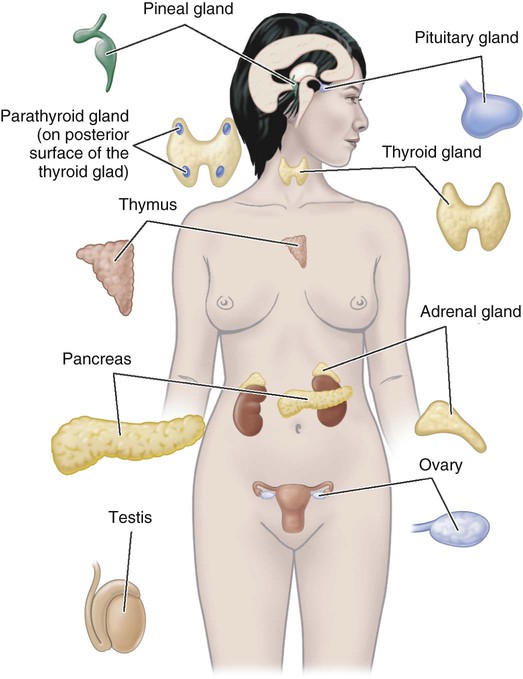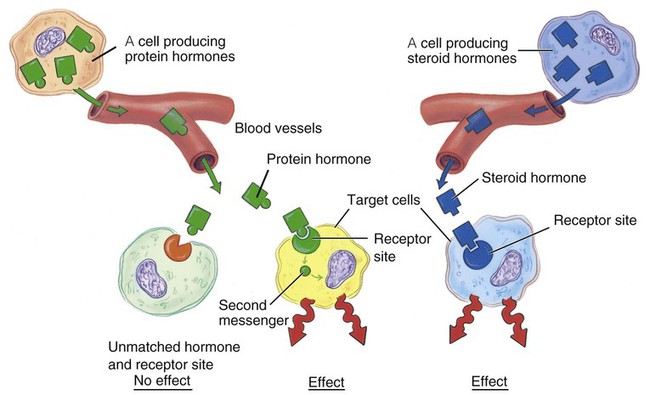1. Compare the actions of the nervous system and the endocrine system. 2. Compare the major chemical classes of hormones. 3. Discuss the general mechanisms of hormone action. 4. Identify the major endocrine glands—pituitary gland, thyroid gland, parathyroid glands, adrenal glands, pancreas, gonads, pineal gland, thymus—and discuss their hormones and function. 5. Describe ways in which the aging of an individual affects the endocrine system. Hormones are potent substances. This means that small amounts of a hormone may have profound effects on metabolic processes. Hormones are carried by the blood throughout the entire body, yet they affect only certain cells. The specific cells that respond to a given hormone have receptor sites for that hormone. This is sort of a lock and key mechanism. If the key fits the lock, then the door will open. If a hormone fits the receptor site, then there will be an effect (Figure 11-1). If a hormone and a receptor site do not match, then there is no reaction. All the cells that have receptor sites for a given hormone make up the target tissue for that hormone. In some cases the target tissue is localized in a single gland or organ. In other cases, the target tissue is diffuse and scattered throughout the body so that many areas are affected. Hormones bring about their characteristic effects on target cells by modifying cellular activity. The organs of the endocrine system are the glands that secrete hormones. Figure 11-2 illustrates that the eight major endocrine glands are scattered throughout the body; however, they are still considered to be one system because they have similar functions, similar mechanisms of influence, and many important interrelationships. Some glands also have nonendocrine regions that have functions other than hormone secretion. The pancreas is one of these glands. It has a major exocrine portion that secretes digestive enzymes and an endocrine portion that secretes hormones. The ovaries and testes secrete hormones and also produce the ova and sperm. Some organs, such as the stomach, intestines, and heart, produce hormones, but their primary function is not hormone secretion. These organs are discussed in more detail in the chapters dealing with their predominant function. Table 11-1 summarizes the major endocrine glands and their hormones. Table 11-1 Principal Endocrine Glands and Their Hormones
Endocrine System
Introduction to the Endocrine System
Characteristics of Hormones
Mechanism of Hormone Action
Endocrine Glands and their Hormones

Gland
Hormone
Target Tissue
Principal Actions
Anterior lobe of pituitary
Growth hormone (GH)
Most tissues in body
Stimulates growth by promoting protein synthesis
Thyroid-stimulating hormone (TSH)
Thyroid gland
Increases secretion of thyroid hormone; increases size of thyroid gland
Adrenocorticotropic hormone (ACTH)
Adrenal cortex
Increases secretion of adrenocortical hormones, especially glucocorticoids, such as cortisol
Follicle-stimulating hormone (FSH)
Ovarian follicles in females; seminiferous tubules of testis in males
Follicle maturation and estrogen secretion in females; spermatogenesis in males
Luteinizing hormone (LH); also called interstitial cell–stimulating hormone (ICSH) in males
Ovary in females, testis in males
Ovulation; progesterone production in females; testosterone production in males
Prolactin
Mammary gland
Stimulates milk production
Posterior lobe of pituitary
Antidiuretic hormone (ADH)
Kidney
Increases water reabsorption (decreases water lost in urine)
Oxytocin
Uterus; mammary gland
Increases uterine contractions; stimulates ejection of milk from mammary gland
Thyroid gland
Thyroxine and triiodothyronine
Most body cells
Increases metabolic rate; essential for normal growth and development
Calcitonin
Primarily bone
Decreases blood calcium by inhibiting bone breakdown and release of calcium; antagonistic to parathyroid hormone
Parathyroid gland
Parathyroid hormone (PTH) or parathormone
Bone, kidney, digestive tract
Increases blood calcium by stimulating bone breakdown and release of calcium; increases calcium absorption in digestive tract; decreases calcium lost in urine
Adrenal cortex
Mineralocorticoids (aldosterone)
Kidney
Increases sodium reabsorption and potassium excretion in kidney tubules; secondarily increases water retention
Glucocorticoids (cortisol)
Most body tissues
Increases blood glucose levels; inhibits inflammation and immune response
Androgens and estrogens
Most body tissues
Secreted in small amounts so that effect is generally masked by hormones from ovaries and testes
Adrenal medulla
Epinephrine, norepinephrine
Heart, blood vessels, liver, adipose
Helps cope with stress; increases heart rate and blood pressure; increases blood flow to skeletal muscle; increases blood glucose level
Pancreas (islets of Langerhans)
Glucagon
Liver
Increases breakdown of glycogen to increase blood glucose levels
Insulin
General, but especially liver, skeletal muscle, adipose
Decreases blood glucose levels by facilitating uptake and use of glucose by cells; stimulates glucose storage as glycogen and production of adipose
Testes
Testosterone
Most body cells
Maturation and maintenance of male reproductive organs and secondary sex characteristics
Ovaries
Estrogens
Most body cells
Maturation and maintenance of female reproductive organs and secondary sex characteristics; menstrual cycle
Progesterone
Uterus and breast
Prepares uterus for pregnancy; stimulates development of mammary gland; menstrual cycle
Pineal gland
Melatonin
Hypothalamus
Inhibits gonadotropin-releasing hormone, which consequently inhibits reproductive functions; regulates daily rhythms, such as sleep and wakefulness ![]()
Stay updated, free articles. Join our Telegram channel

Full access? Get Clinical Tree


Endocrine System
Get Clinical Tree app for offline access

